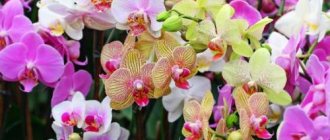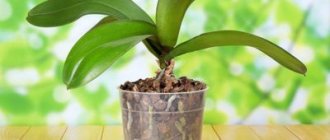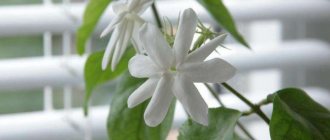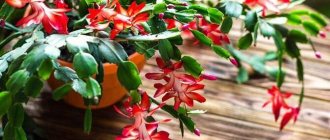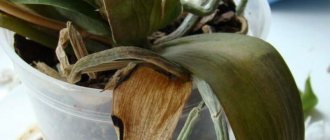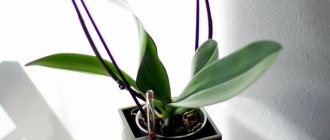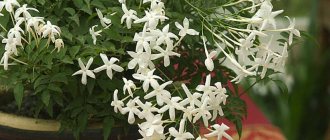Phalaenopsis are considered the most blooming orchids at home. They are valued for the minimal amount of effort required on the part of the grower for care and flowering.
But it happens that the standard categorically refuses to drive out the peduncle and spends all its energy on growing leaves. This is how the orchid stands, non-blooming, only with leaves.
The orchid does not bloom, what to do to make it bloom. Reasons for absence
After flowering, phalaenopsis, like other indoor flowers, enters a period of rest.
During this time, the standard restores lost strength and gains new ones. Next comes a period of active growth, when the flower can expel a couple of young leaves and a new peduncle.
If an orchid does not bloom for a long time at home, it is worth thinking about the reasons for this phenomenon.
The period during which the peduncle should appear is different for each variety; in some phalaenopsis it appears along with the leaf, and some expel it after the leaf blade has fully developed.
Young phalaenopsis peduncle.
Usually the reason that an exotic beauty does not bloom are:
- transferred stressful condition, in which even damage to the plant is possible. Stress for an orchid means a sudden change in the environment; this usually occurs when moving or when transporting a standard from a store to home during the cold season. In this case, it is possible to get frostbite or simply hypothermia of the plant;
- diseases will get in the way of flowering if the roots or leaves are affected. The plant simply does not receive enough necessary nutrients and will not be able to produce a high-quality peduncle. Shtamb simply does not have enough strength;
- poor care will also not accompany variegated flowers, only normal watering with a sufficient amount of fertilizer. A place without drafts, bright, but without direct sunlight, will promote the growth of the peduncle and the further development of flowers on it.
In addition, the lack of flowering may also be caused by improper proximity of plants, which should be strictly observed.
Advice! You should not grow banana trees and tomatoes on the same windowsill or near phalaenopsis. In the summer, protect the trunk from being close to apple and walnut trees.
Their effectiveness and cost
Among many different brands, orchid lovers most often choose the following fertilizers:
| Name | Composition and application | Estimated cost |
| "A clean slate for orchids" | Compound: · Nitrogen – 32, · Phosphorus – 16, · Potassium – 15, · Microelements, · Phytohormones. Fertilizer is used during the period of active growth and is canceled when the peduncle grows. Application method: half a measuring spoon per 2 liters of water. | 25 rub. per 100 g |
| "Absolute for orchids" | Microbiological fertilizer for growing and flowering orchids of any type and variety. Recommended for adding to the hearth during submersible irrigation. 20 ml per 1 liter of water. Fertilize no more than twice a month, depending on vegetative development. Do not use during rest period. | 330 rub. for 250 ml |
| “Effect – universal fertilizer for orchids” | Compound: · N (nitrogen) -4%, P (phosphorus) – 2.5%, K (potassium) – 7% Mesoelement: magnesium – 1.3% · Microelements: boron, manganese, copper, zinc, iron, molybdenum, cobalt. · Vitamins: B1, PP, C. · Root formation stimulator – succinic acid. Application rate: 5 ml per 1.5 liters of water. | 370 rub. for 285 ml |
All-purpose orchid fertilizers are suitable for phalaenopsis.
In addition to mineral elements, phytohormones are used for orchid flowering. The most popular is cytokinin paste . With its help, you can achieve guaranteed flowering if used correctly.
It is usually used on old peduncles left over from the previous flowering. In order to stimulate the germination of a flower bud, a small amount of paste is placed under the cover scale. It is important to overdo it with the amount of stimulant, otherwise a leaf shoot will form instead of a peduncle.
The orchid has released a peduncle, but is not blooming. Step-by-step instructions on how to care if there is no flowering
Option No. 1: Let's look at how to care for an orchid if it does not produce a peduncle and leaves and roots do not grow.
When there is no growth and flowering of an orchid, the reason may lie in systematic and frequent watering, and the absence of differences between day and night temperatures. To solve this problem you need:
- Place the pot on a windowsill where there is bright light but no direct rays.
- Water the flower once every 10–12 days after thoroughly drying the soil.
- Provide orchids with a difference in night and day temperatures of 5 - 7 degrees.
Option No. 2: When the orchid only grows roots, but no buds appear.
If there is no leaf growth and no flowering of the orchid at the same time, then the reason is regular, frequent watering and equal day and night temperatures. To solve this problem, you must follow the following recommendations:
- Place the pot on a windowsill where there is bright light but no direct rays.
- Watering should be done once every 10 – 12 days.
- In between waterings, thoroughly dry the soil.
- You also need to ensure that the orchid has a difference in night and day temperatures of 6-8 degrees.
Option No. 3: If the orchid produces only leaves, but not flower stalks.
Active vegetative growth of leaves and lack of flowering indicate an excess of nitrogen fertilizers in the soil. To solve the problem, it is important to spend a dry season for the flower.
- Allow 4 days between waterings to allow the roots to dry out.
- Stop spraying and fertilizing until the flower stalk appears.
- Organize proper lighting, add cold light lamps in winter. Keep them at a distance of 40 cm from the top of the head.
Artificially create a lack of moisture and ensure the temperature is around 30 degrees. After 1 – 2 months, flower buds will appear.
If the “drought” is carried out correctly, the peduncle will begin to actively grow, and the lower leaves will become softer.
Option No. 4: The orchid has released a peduncle, but still does not bloom.
If an orchid has released a peduncle, but only leaves and roots are growing, and still does not bloom, do not panic. This is an individual feature of many varieties, when the plant gains buds, but does not bloom them for up to 3 months.
Bloom
Reasons for absence
The most precise formulation of the problem is inappropriate conditions. Flowering is a sign of plant health.
After the purchase
It takes time to get used to new conditions after purchase. A change in habitat is in itself a big test for a plant.
In nature, a flower stays in one place all its life, in a familiar environment. When the temperature regime, lighting angle, and substrate temperature change sharply, the plant has to rebuild the functioning of its tissues.
Transportation of a plant always leads to microtraumas of leaves and aerial roots, even very carefully. Also, during the “travel” there is often additional stress in the form of temperature changes.
The green pet needs to be created with optimal living conditions, close to natural ones, and given time to heal damage and adapt in general.
It is impossible to say exactly how long it will take. You can focus on a period of 12 months. If flower stalks still do not appear, it’s time to take action.
If the plant does not develop at all
If the plant has stopped developing as a whole, does not grow new leaves and, especially, does not bloom, you should start with general care and check the conditions of the plant. If properly cared for, stimulation of flowering is not necessary at all.
Substrate
If tree bark is used as a substrate, then such material should not be fresh. It should also not contain fresh sawdust. Substances made from such materials are harmful to orchids.
Tree bark as a substrate.
In winter, the plant may stop growing and blooming due to living on a cold windowsill. If there is no other place for placement, you need to organize at least a stand.
IMPORTANT! In summer, the intensity of solar radiation goes off scale and can even cause burns on delicate leaves. Indeed, in its native tropics, the phalaenopsis orchid grows in the dense undergrowth of the jungle, where there is no direct sunlight
To avoid such unpleasant consequences, it is worth protecting the plant with blinds or any available method.
Lighting
In winter, when daylight hours are short and dim, the orchid may “starve” because there is not enough sunlight for the full process of photosynthesis.
During this difficult period, the tropical plant needs additional lighting.
This is easy to organize with the help of specialized phytolamps. These lighting devices emit a spectrum of light waves that are most favorable for the process of photosynthesis.
IMPORTANT! In summer, the intensity of solar radiation goes off scale and can even cause burns on delicate leaves. Indeed, in its native tropics, the phalaenopsis orchid grows in the dense undergrowth of the jungle, where there is no direct sunlight
To avoid such unpleasant consequences, it is worth protecting the plant with blinds or any available method.
Watering
Excessively abundant watering will not bring any benefit, as will extremely infrequent watering. When there is too much water, it can stagnate in the pot and rot can form on the roots. In this case, the exhausted plant has no chance of flowering.
Insufficient watering is not so harmful, it can even imitate the dry season in the tropics, but still should not be overused.
Determining the frequency of watering.
Top dressing
When phalaenopsis just begins to produce new leaves, this is an excellent moment for feeding. Flower buds, from which flower stalks will subsequently appear, are laid simultaneously with new leaves.
If such a moment is missed, and in addition the watering was incorrect, weak buds will be formed that have nothing to please.
Phalaenopsis orchid does not bloom, what to do? Analysis of orchid keeping conditions
When buying a flower, you need to ask a specialist for an explanation of what variety it is and the characteristics of its cultivation. Phalaenopsis orchid, the most unpretentious variety that tolerates light shading. But there are orchids for which a south window is suitable, and even summer heat is tolerated well by them. An orchid does not bloom if the conditions of its maintenance are violated.
You should always place a saucer of boiled water next to the orchid. Place a clove of garlic in the substrate.
If the flower was purchased in a store, and it was already blooming, and the arrow turned yellow, then the rest period can last up to a year. If the plant is grown from children, then it will take more than two years to wait for the first flowering. By this time, the root system will gain strength and the orchid will produce 5-6 leaves. Early flowering will weaken the beauty.
Why doesn’t an orchid bloom at home after transplantation? When should we expect the first arrow? The transplanted plant initially builds up its root mass within six months. Afterwards, aerial roots develop and leaves grow. Flower buds are formed in the axils. The initial period of plant development in favorable conditions contributes to the laying of a larger number of flower stalks.
Let us remind you how to properly maintain an orchid:
- The roots are well developed, green, some of them are located on the walls of the transparent pot, some are at the top, absorbing moisture from the air.
- The substrate does not contain fresh bark, sawdust or manure.
- It is better to keep the lighting diffused.
- The difference in day and night temperatures when planting flower stalks should be at least 5 degrees.
- Fertilizing with liquid fertilizers depleted in nitrogen once every 10 days before the arrow shoots.
The conditions for laying flower buds are listed, but biological requirements for the maintenance of orchids must be observed.
What to do if the orchid does not bloom or develop well? It will be necessary to provoke the release of the arrow. The aerial root and the arrow look the same at first. But the tip of the arrow is rounded, and at the root it is sharp, as in the photo.
What affects flowering
The most demanding plant, the orchid, is something every novice gardener needs to know about how to care for it at home so that it blooms.
Orchid blooms are beautiful both in nature and at home
An important factor is the age of the plant. The first time an orchid begins to bloom is when it is one and a half years old. There are species in which flowering begins much later
To determine the age of a flower, just pay attention to the number of shoots. If there are more than five of them, the plant is considered mature and should bloom
Important! If an orchid begins to bloom earlier than a year and a half later, this leads to its depletion. She will not be able to recover and will soon die
Flowering also depends on other factors that you should pay attention to.
Place
An orchid is a plant that needs rest, so under no circumstances should it be moved. In addition, the flower is sensitive to light. Immediately after purchase, you need to make sure that the pot is turned towards the light as it was in the store.
It is important that the daylight hours for a flower at any time of the year last at least 10 hours. In winter, additional illumination with phytolamps is necessary.
These devices replace sunlight for the plant without drying out the air.
Important! Without additional good lighting in autumn and winter, the plant will stop developing and die. Especially if it has released a peduncle
The roots of the plant, like the leaves, take an active part in photosynthesis, and they also need a lot of light. Otherwise they will start to get sick and die.
When replanting, it is important to choose the right pot. It should be plastic and have enough holes for drainage
You cannot take pots with a loose surface, as the root system may grow onto it. The sharp edges of the container cause injury to the roots, which ultimately negatively affects the entire plant.
Fertilizers
For abundant flowering, the plant needs to be fed with fertilizers containing phosphorus and potassium. These minerals have a beneficial effect on the growth and development of the flower. It is not recommended to fertilize it with nitrogen-containing substances, since they stop the formation of flower stalks.
Watering
What and how to water orchids so that they always bloom? The flower needs moisture only when the soil is completely dry. This protects the root system from rotting. The watering procedure must be carried out both in summer and winter.
Important! After the plant has flowered, re-watering is done only after a month. Under natural conditions, after flowering, all representatives of the Orchid family begin to develop and ripen seeds.
The period occurs during dry weather, so it is important to create favorable conditions in the house for plant propagation
Under natural conditions, after flowering, all representatives of the Orchid family begin to develop and ripen seeds.
The period occurs during dry weather, so it is important to create favorable conditions in the house for plant propagation
Unlike the soil, the air around the plant must be moist. This condition is necessary for the normal development of the flower and its buds. Optimal air humidity can be created by placing a saucer filled with water near the pot, or by spraying the flower itself.
Water the orchid every 10-14 days
Temperature
For favorable flowering, an important role is played by the change in temperature at night and during the day. The difference between the thermometer readings should be no more than 6 degrees and no less than 4. It is quite problematic to create such an atmosphere indoors, so from the end of May the flower must be taken out into the open air. This way, nature itself will take care of optimal conditions for flowering.
In winter, it is important to ventilate the room, but drafts should not be allowed to occur. They can destroy the plant
Why doesn't an orchid bloom for a long time? Why doesn’t an orchid bloom at home and what to do about it?
Growing orchids is inextricably linked with the anxious anticipation of their flowering. During this period, plants become unusually spectacular, revealing their exotic beauty to the fullest. However, it often happens that for one reason or another, capricious tropical flowers do not bloom. Sometimes the duration of “flower silence” is calculated in years. For what reasons may orchids not bloom at home, what needs to be done to correct the situation?
Why doesn't the orchid bloom?
Flowering time, its frequency and duration depend on the characteristics of the plant variety. Most varieties begin to form the first buds at the age of 1.5-3 years. To determine the age of an exotic plant, it is necessary to count the number of shoots in its rosette - for example, two-year-old plants have at least 5 of them. Orchids usually bloom once every 2-3 months. Proper care and care of the plant ensures its flowering 2-3 times a year. Experienced plant growers claim that if an exotic plant does not form flowers for more than a year, then this clearly indicates the presence of some kind of problem.
At the same time, plants that stubbornly do not bloom can feel quite at ease. They produce new leaves, roots grow, and even flower stalks form. However, the formation of buds on peduncles does not occur. It even happens that an orchid can release a peduncle, which dies very quickly. The main factors due to which orchids do not form buds and bloom are:
- natural causes;
- improper care.
Causes of orchid leaf loss
Sometimes the leaf blades of a plant begin to quickly die and the bush quickly loses its foliage. As a result, the orchid itself dies. This happens for various reasons, here are the most common ones.
End of flowering period
Sometimes after lush flowering the plant loses some of its leaves. If these are 1-2 leaf plates, then this should not worry the grower. It’s bad when the bush is left completely without leaves. If this happens, then it is worth finding the reason.
Losing a few leaves after flowering is a natural process.
Natural process
For an adult bush, losing one leaf per year is normal, as long as it grows new leaves. This is a natural process of aging of the lower leaves. And this should not cause concern to the gardener.
Poor root condition due to overwatering
When watering is carried out with enviable frequency and a large amount of water, the moisture from the soil does not have time to evaporate, under these conditions the root system of the plant can begin to rot.
A small number of roots will not be able to feed many leaves and the excess ones will begin to die. In this case, it is necessary to urgently begin to grow new roots so that the flower does not completely shed its foliage.
IMPORTANT! It is necessary to organize the correct watering regime with soft water.
Chemical burn of the root system with fertilizers
If the plant was fed with dry roots, this causes a burn to the root system and it begins to dry out. As the number of roots decreases, the amount of leaf mass decreases.
The flower is fertilized only after watering the wet root system.
Chemical burn of roots.
Drying out the plant
With rare watering, the orchid dries out part of its roots, since they do not receive the required amount of moisture. Then, as usual: no roots - no foliage. We urgently need to resuscitate the flower and grow its root system.
How to save a plant without leaves? We will answer further.
Orchid, what to do if the orchid does not bloom. If the orchid does not bloom: what to do, what to do?
Everything written above sounds attractive, doesn't it? But, as they say, “it was smooth on paper, but we encountered ravines.” So it is in floriculture. It’s nice to read advice and look at colorful pictures of flowering plants on the pages of portals. But it’s worth listening to the advice and understanding for yourself what to do if orchids don’t bloom for a year or even longer. This situation is no longer normal and signals that something is wrong with your beauty. But what exactly is worth figuring out.
First, remember that in order for orchids to bloom, they need to create the appropriate conditions:
- the root system must be able to provide complete photosynthesis; for this, part of the roots must be above the pot to absorb excess lag from the surrounding air, and the lower roots are placed on the sides of a special substrate in a transparent plastic or glass pot;
- the soil should not contain fresh sawdust, fresh bark or, God forbid, fresh manure - all these substances make it impossible to plant and release a peduncle;
- lighting should be diffused - under direct sunlight, the root system dies and dries out;
- the ambient air temperature should have a daily difference of 5 degrees Celsius - at night it is necessary to move the pot with the plant to a cooler place (in winter you can get out of this position by moving the orchid to the central heating radiator and away from it, but constant spraying with warm water is necessary) ;
- fertilizing should be carried out at least once every 10 days.
Everything seems to be done, but the orchid still doesn’t bloom: what to do in this case? You may need to apply some tricks that professional flower growers use. We'll talk about this further. In the meantime, it would be a good idea to learn how to replant an orchid correctly.
Are you warm, orchid?
Optimum air temperature +20…+30°C. You can often come across recommendations to necessarily lower it in the winter, but there is no practical benefit in such advice: phalaenopsis does not have a rest period, they vegetate all year round. But lowering the night temperature by 7-9°C below the daytime temperature is justified, even moreover, it is mandatory: such a difference imitates the natural living conditions of the plant and ensures the establishment of flower stalks. Beginning flower growers are horrified by this feature of phalaenopsis and give up, not imagining how to achieve a temperature difference. In fact, everything is not so complicated, the methods are simple and accessible to everyone. For example, you can leave a window for micro-ventilation overnight (but do not forget to make sure that frosty air does not fall directly on the plant).
Leaf turgor may decrease due to low air humidityThe optimal air humidity range for phalaenopsis is 60-80%, critical - 40%. Dry air will have an extremely negative impact on the plant: the orchid will try to survive and will direct all its efforts to the formation of aerial roots. The buds and already blooming flowers will fall off, the leaves will lose their elasticity, and the vital energy of the phalaenopsis will rapidly decrease. Obviously, you will have to wait a long time for flowering, and in especially severe cases it may not occur at all: the plant will simply die. But it’s worth adjusting the air humidity, and the grateful orchid will definitely bloom. We list the most effective methods of increasing air humidity - all you have to do is choose the appropriate option:
- regularly ventilate the room, especially on rainy days or during a thaw;
- place several containers (you can use plastic cups) with water around the orchid pot;
- Fill a large (by area) tray with pebbles or expanded clay and place pots with plants on it. Pour water into the pan, but only a little so that it does not fall into the drainage holes;
- put a humidifier in the room.
The orchid does not bloom. Why don't orchids bloom?
Many amateur flower growers do not understand why their orchid has not bloomed for a year or 2 years. Let's take a closer look at the main question: why don't orchids bloom and what to do at home if a problem arises?
Care errors
The duration and frequency of flowering of an orchid depends both on the conditions of its maintenance and on its belonging to a particular species or variety.
If not properly cared for, the orchid will not bloom.
Hybrid varieties adapted for growing at home are characterized by cyclical flowering up to 2-3 times a year with breaks for rest. Violation of this rhythm indicates mistakes made when caring for the plant, resulting in non-flowering orchids.
Temperature violations
The homeland of orchids is humid and warm tropical forests, so when kept indoors it is necessary to maintain the correct temperature regime:
- At temperatures above 25-30℃, plants intensively grow green mass and bloom poorly; in winter, the temperature should not fall below 16℃. The optimum temperature for an orchid is 20-24℃;
- The formation of peduncles is well influenced by daily fluctuations in day and night temperatures within the range of 5-7℃.
This corresponds to the natural life cycle of the plant, during which a safe flowering mechanism is launched.
Lighting nuances
One of the main factors that affects the development and flowering of an orchid is light. Incorrect lighting causes stress:
- The leaves stretch out, their color becomes lighter;
- Growth slows down and flowering stops;
- A peduncle does not form;
- Direct sunlight in summer causes burns on the leaves.
The plant is sensitive even to such nuances of lighting as turning the pot around or moving it to another place, which can cause the flowers to drop.
Irrigation technique
Novice gardeners sometimes get too carried away with watering, which results in problems for the orchid:
- Frequent watering stimulates the development of vegetative parts: roots and leaves;
- Excessive moisture can cause roots to rot, causing them to become dark in color. This plant will not bloom.
The watering regime must be adjusted, and if rotten roots are found, the plant is transplanted into new soil.
Incorrect composition of fertilizing
An incorrectly selected fertilizer composition can be a factor due to which an orchid does not form a peduncle, for example, a variety such as cymbidium:
- Excess nitrogen stimulates the growth of the root system and leaves;
- Phosphorus in fertilizers stimulates the formation of peduncles.
Important ! For feeding, you need to use only special fertilizers for orchids with a low nitrogen content.
Before feeding orchids, make sure that the fertilizer contains the correct composition.
Above you can see a photo of what fertilizers for orchids at home from Bona Forte look like. The optimal ratio of nitrogen, potassium and phosphorus to stimulate flowering is 2:6:6.
After transplant
The roots of the plant are very sensitive to transplantation and take a long time to recover after it. The lack of flowering during this period may be due to the fact that:
- During the first half of the year after transplantation, the root mass actively grows. Then aerial roots form and leaves grow, in the axils of which flower buds are laid;
- If too many roots had to be removed during replanting, the flower may not adhere well to the substrate, which will make flowering difficult;
- Incorrect plant maintenance and growing conditions have a particular impact.
Comfortable conditions created after transplanting an orchid determine good growth, development and early flowering.
Violation of the root system
If the plant is transplanted incorrectly, damage to the root system is possible:
- Root rotting due to improperly selected substrate;
- The volume of the pot is too small for the root system;
- Injury to roots during transplantation due to their ingrowth into the walls of the pot.
If the transplant was carried out correctly, but flowering does not occur, a possible reason may be improper care of the orchid.
The soil does not support the plant
If an orchid is poorly anchored in the soil for a long time, this may affect its ability to form a peduncle. In this case, the plant must be transplanted into a suitable substrate or soil must be added to the pot.
Healthy
Sometimes an apparently healthy plant has problems with flowering: either the orchid does not bloom or quickly fades.
Fattens and does not produce a peduncle
The reasons for non-flowering can be different:
- Monotonous watering of the plant has a positive effect on leaf growth;
- Nitrogen predominates in fertilizing, and the orchid quickly increases its leaf mass.
Adjusting the watering and nutrition regime will help restore flowering.
Gives only children
Most likely, the temperature regime is not observed: during the day +22-24 degrees, at night +16-18 degrees. An excess of nitrogen in fertilizing is also possible.
If feeding is poor, the orchid does not bloom, but only produces babies.
Has released an arrow, but does not bloom
The orchid shoots, but the flower does not bloom for a long time. This is often due to uncomfortable growing conditions:
- If the peduncle appears in the dark season without additional lighting, the plant will not have the strength to flower normally;
- Low air humidity or close proximity of heating devices causes drying of the flower stalk.
With proper care and following the recommendations, the orchid will feel great at home and delight you with lush flowering.
The influence of diseases and pests on the development of peduncles
A plant affected by a fungal disease or insects (aphids, soft-bodied mites, scale insects, etc.) has stopped blooming, what to do in this case?
Attention! The main cause of orchid disease is weak immunity, a consequence of improper maintenance and care.
Treatment involves the use of fungicides or insecticides. After the recovery period, the plant will bloom again.
Drops flowers and buds
The reasons why an orchid sheds flowers and buds include:
- Old substrate that has already decomposed and rotted;
- Rearrangement to another location during flowering;
- A nearby air conditioner or cold draft;
- During flowering, the air temperature rose above 30℃;
- A flowering plant is not fertilized;
- You can only spray the leaves, not the flowers.
With proper care, the orchid will delight you with flowering for many years.
The orchid's bud woke up on its own - what to do?
If the apical (outmost on the peduncle) bud of a flowering orchid unexpectedly awakens, then flowering will continue and several smaller flowers will additionally appear. You should not touch the peduncle unless there is a danger of weakening the plant.
If a bud appears suddenly, it is not recommended to touch it unless it harms the orchid.
The bud under the flower closest to the base of the arrow (lateral) may awaken on its own - cut off the inflorescence, retreating 3 cm from the hatched bud, from which a new peduncle or baby will then grow. But you can let the orchid bloom and only then cut off the remains of the inflorescence.
Why doesn't the orchid bloom, but only leaves and roots grow?
To establish the reason for the lack of flowering, you need to know the basic rules of care and external signs of a healthy orchid.
State of the root system
The development of the root system is closely related to the state of the above-ground part of the orchid. No matter how many aerial roots a plant has, it is important that they look healthy. By the appearance of the roots you can judge what the plant lacks:
- darkening of the roots is a sign of waterlogging and rotting;
- the appearance of a large number of aerial roots – increased dryness in the room.
Normally, the growing root tips are bright light green in color. If they are not visible for several months, it is necessary to reconsider the care of the plant.
Healthy root system.
Substrate composition
Fresh bark, sawdust or manure does not contribute to the emergence of a peduncle. Unlike other indoor plants, orchid roots are not able to absorb nutrients from the soil, so they need a specially selected substrate.
Important! An incorrectly selected mixture will cause waterlogging and rotting of the roots, in which case the plant will not bloom.
The composition of the substrate for orchids usually includes:
- pieces of pine bark;
- inert material (foam balls, expanded clay);
- sphagnum moss.
Substrate for orchids.
Sometimes other components are added to it. The following should be taken into account:
- fresh bark can be a source of infection, causing the plant to become sick. Before use, pieces of bark are boiled for 1 hour in order to get rid of pests and microorganisms, as well as resin residues;
- sawdust cannot be added to the substrate, as it consists of very small particles, which stick together when watered and disrupt the aeration of the roots;
- manure contains too many mineral and organic substances that are harmful to orchid roots.
A properly selected substrate is the key to the health and regular flowering of an orchid.
Lighting
Light is one of the main conditions for the good development and flowering of an orchid. If the lighting is chosen incorrectly, this will affect the condition of the plant:
- the leaves stretch out and become lighter;
- growth slows down and flowering stops;
- a peduncle does not form;
- Direct sunlight in summer causes burns on the leaves.
Even unwrapping the pot or moving it to another location can cause stress, resulting in a lack of flowering.
For regular orchid flowering you need:
- a large amount of diffused light;
- in the autumn-winter period, daylight hours are extended to 12 hours using a special phytolamp.
Insufficient duration of lighting in winter is the main factor due to which an indoor orchid does not form a peduncle.
Daily temperature difference, optimal temperature day and night
In nature, orchids grow in tropical forests, so in indoor culture, moist and warm cultivation conditions are most suitable for them:
- in summer, the optimal temperature in the apartment is 15-30℃, in winter – 20-23℃;
- The formation of a peduncle is stimulated by daily fluctuations in day and night temperatures within 5-7℃, which allows the plant to safely turn on the flowering mechanism.
In summer, such a natural temperature difference is created when growing an orchid on the balcony.
In summer it is recommended to grow orchids on the balcony.
Top dressing
Lack of flowering may be a consequence of improper feeding with an unbalanced fertilizer composition.
Attention! If there is good growth of the roots and leaves of an orchid, but the plant does not bloom, the most likely reason is the increased nitrogen content in the fertilizer.
Conventional phosphorus-potassium fertilizers are not suitable for feeding this plant. It is better to use special fertilizers for orchids with a low nitrogen content:
- fertilizing is applied only during the period of vegetative growth;
- Before fertilizing, water the plant so that the fertilizer does not cause burns to the roots;
- in the winter months, as well as in summer at temperatures above 24℃, fertilizing is applied once a month, in spring and autumn - once every two weeks.
- A plant that is in the leaf and root growth stage has a greater need for nitrogen.
- When forming flower-bearing arrows - in phosphorus and potassium.
Creating comfortable conditions
To achieve flowering of phalaenopsis, it is provided with the following growth conditions:
- Humidity. Must be at least 50%. To do this, the orchid is regularly sprayed with settled water and a container of water is placed next to the flowerpot.
- Lighting. Bright, but without direct sunlight. At least 14 hours during the growing season and 10 hours during dormancy. If necessary, use artificial lighting.
- Watering . Abundant but rare. You need to wait until at least 60% of the entire substrate has dried. Frequently moistening the soil will cause the roots to rot.
- Feeding. Choose special fertilizers for orchids. Use according to instructions. Experienced gardeners advise slightly reducing the indicated concentration.
- Air temperature. In summer, maintain within 25–28 degrees, and in winter – 20–23 degrees.
Read more about plant care for frequent and abundant flowering in this article.
Briefly about what to do
If there is no flowering, first of all you need to make sure that the plant has fully grown, matured and formed flower stalks. If the growth period has ended and there are still no flowers, a thorough examination of the orchid is recommended to identify diseases, pests and irregularities in care.
After treatment and normalization of living conditions, phalaenopsis will certainly delight the owner with its beautiful flowers. And if the plant has a long dormant period, you can use extreme methods to stimulate flowering (read about how to make an orchid bloom here).
If you want to learn more about orchid blooms, we offer
When and how does it bloom?
This type of orchid, unlike others, can bloom at any time of the year. The frequency and duration of phalaenopsis flowering directly depend on the conditions of maintenance : the amount of watering and the content of minerals in the fertilizer, lighting and temperature in the room where the plant is located.
Usually flowers appear twice a year, and sometimes three times, and last from 2 months to six months. The petals of a blossoming phalaenopsis resemble the wings of an exotic butterfly, striking in their variety of shades - they are found in both plain colors (white, red, purple, yellow) and with veins, specks, and spots. The diameter of the inflorescence is from 2 to 15 cm.
How is the period after flowering?
Every gardener should know what to do with a faded peduncle. This is an important stage of plant care. So, when the orchid has finished blooming, you can cut the peduncle.
After a wonderful period, as soon as the last flower has fallen and the orchid has faded, the stem is removed. Some gardeners claim that this component of the plant nourishes the rest of the “home beauty” with its juice, but this is not so. Therefore, if an orchid has faded, the stem must be cut off.
This method helps in achieving the following results:
- The orchid no longer wastes energy on an empty peduncle, directing it to more important areas of the plant.
- After removing the old peduncle, new ones will appear much earlier.
- Aesthetic component.
Do not remove the peduncle
If there are no definite thoughts on what to do with the peduncle, if the orchid has faded, then you can leave everything as it is.
Each living arrow, in addition to a set of buds and flowers, also contains a tip. If it is still green, then there is a chance that the peduncle will branch again and delight with flowering.
Some varieties of orchids, such as dendrobium, can form new and new peduncles for a long time, which live on average for 2 weeks, and if they are removed after each flowering, this will lead the “pet” to a period of dormancy prematurely.
Partial pruning of an orchid after flowering
It would also be a good idea to partially prune the orchid after flowering.
Each peduncle is equipped with buds; until buds and stems form from them, they sleep. When the orchid has faded, you can cut off only that part on which there are no longer living and “dormant” buds left in order to save the plant from unnecessary costs. Available forces must be directed to the formation of new buds.
In order to carry out partial pruning without loss or harm to the plant, after the orchid has bloomed, use disinfected tools. If the buds are located below the points of the previous flowering, then leave a margin of up to 2 centimeters before them. This is done in order to provide nutrition to the “dormant promising buds”.
As a result of partial cleansing of the peduncle, a new one will appear much faster, which will soon also bloom. Such manipulation will make it possible to reproduce by stems.
How to determine the source of the problem?
To understand why phalaenopsis does not bloom, you need to pay attention to the care and appearance of the plant. If the flower appears healthy and does not have any defects, the reason is probably due to improper conditions of its maintenance. In this case, adjusting the lighting, fertilizer composition and air temperature at home should lead to the desired effect.
In most cases, the lack of flowering is just one factor indicating that something is wrong with the orchid. Other possible signs of poor care or disease: yellowing and wilting of leaves, the appearance of “rusty” spots or bumps on them, rotting or drying of the roots. Methods for treating phalaenopsis diseases and controlling parasites have already been mentioned above.
When should you start worrying?
On average, the dormant period of phalaenopsis lasts up to three months. At this time, it gains strength before a new flowering. If, after the specified period, the plant does not begin to shoot arrows in order to then form inflorescences, you need to pay close attention to it (read more about what the peduncle of a phalaenopsis orchid is and how to distinguish it from the root or other parts of the plant).

